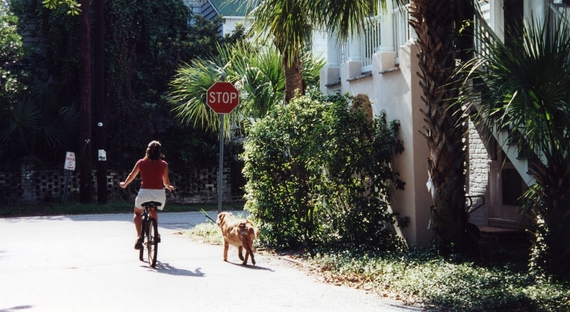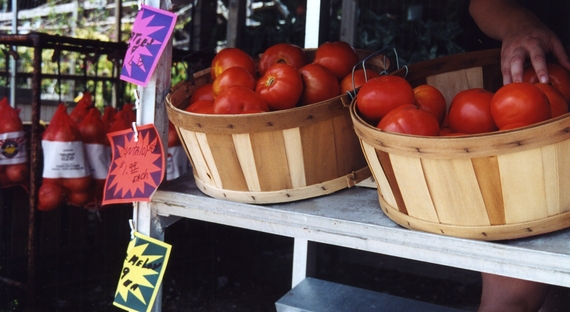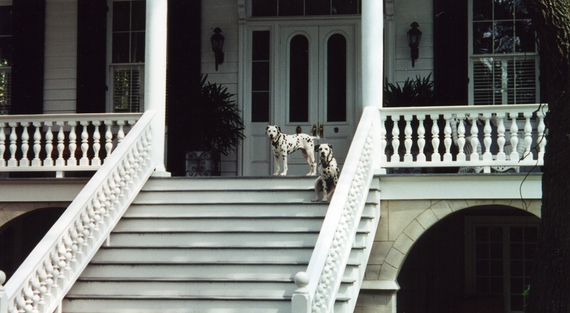When it comes to the mechanically cooled contemporary American South, this may be close to blasphemy. But here goes: Some of us do not like central air. Indoor breezes are indoor breezes, if you ask me. You might be in a mall, or at the movies, or driving around in your car.
But if you want to catch the seasonal thickness of a late September night, you find yourself rolling through South Carolina with the windows down, or propping open the door of your motel. You search and search for towns near the coast that have a mix of saltiness and farminess in the air, and were laid out to breathe in this elixir, not freeze-dry it.
And -- just as I was several years back -- you are very happy to find Beaufort, S.C.
Once known as the "Newport of the South" because of the mansions built here by wealthy planters of rice and cotton, and famous more recently as a sort of Hollywood South (The Prince of Tides, Forrest Gump and The Big Chill were all filmed here), Beaufort is famous for its carefully preserved pre-Civil War homes. Many of these are outfitted with two-story, colonnaded porches and southeast frontages to make the best of the available winds. And although Beaufort is about halfway between Charleston and Savannah, Georgia, when you visit you feel as if you are in a separate seaside dominion with its own, sometimes lavish, local atmosphere.
Everywhere you turn there are live oaks with dangling shreds of Spanish moss and inlets edged with soft-looking marsh grass that changes from a light green to gold as summer moves toward fall. Small boats promenade up and down the Intracoastal Waterway, and you can sometimes see groups of bottle-nosed dolphins close to shore as they use the tidal eddies in an attempt to outwit schools of fish.
Beaufort, pronounced BEW-fort, is a friendly place where people like to use each other's name as often as they can. ("Roger, is it March when soft-shell crabs get on local menus?" "Well, Eric, I think that's right.") It is also the semiofficial headquarters of South Carolina's Sea Islands, which include such well-known destinations as Hilton Head and Parris Island, with its Marine Corps basic training center, but also hundreds of barely charted, Gilligan-size places.
Lady's Island, Cat Island, Cane Island, Coosaw Island, Distant Island, Spring Island. On some of these you find full-scale resorts, and on others fishing shacks on stilts, minor crossroads and, you begin to think, more herons than human inhabitants. But here and there, you can discover Gullah communities that are partly made up of descendants of slaves who were brought here from Africa's west coast, and that are infused with a distinctive African American culture and dialect.
Gullah settlements on St. Helena Island such as Wallace, Capers and Coffin Point tend not to show up on signs, so you may not know you are nearby unless you ask or, perhaps, unless you have heard Sea Island words and phrases mixed into speech. For instance, a Gullah speaker might ask, "Hah onnah da do?" instead of "How are you doing?"
One of the area's points of pride is that the Emancipation Proclamation was first applied in Beaufort and the islands on Jan. 1, 1863, since, at that point, it was the only major chunk of the South occupied by Union troops. During the Civil War, Philadelphia missionaries set up the nation's first school for freed slaves -- the Penn Normal School on St. Helena -- and you can visit it in its present incarnation, the Penn Center, where during the early 1960s, Martin Luther King Jr. and his staff were said to have drawn up plans for the March on Washington.
I liked Beaufort the minute I saw that it was surrounded by fried chicken restaurants and small-scale roadside diners instead of Applebee's and T.G.I. Friday's. Although well-heeled retirees have discovered the area and kicked off a housing and retail boom, there was less sprawl than I expected.
Roads leading in and out of Beaufort seemed a bit sleepy, with the occasional Piggly Wiggly supermarket or Huddle House coffee shop popping up at a busy corner. Mostly, though, I found dense, prehistoric-looking forest on both sides and fresh vegetable and fruit stands advertising such edibles as cherry-peach cider and hot boiled peanuts.
The region's staple crops used to be indigo and cotton, but now there are melons and strawberries and green peppers and extraordinary dark red tomatoes. Some of these are picked early and trucked out of state, but a few are allowed to ripen. I looked them over and squeezed them (just to see if they were real) at establishments like Dempsey's along Sea Island Parkway on St. Helena, where you could pick your own produce right off the vines, or from the stands at the unassuming Barefoot Farms, a few miles down the same road.
Owner Jackie Frazier was well known locally for the fact that he never wore shoes. ("There are no stones in this part of South Carolina," I was told, "so he doesn't need to.") But otherwise Frazier was a fount of innovation, growing all of his produce vertically on sturdy poles staked out in a greenhouse behind his stand and, for reasons I never completely understood, planting his strawberries inside what appeared to be individual serving-size cardboard crates.
Another local character I had to drive a bit farther to track down was Harold Peeples, who operated an unparalleled roadside attraction in the whistle-stop town of Yemassee, about 20 miles inland. It was known as Harold's Country Club, but there were no swimming pools here. Harold's was a hard-working, grease-spattered Exxon station that, without noticeably tidying up, turned into a family restaurant three nights a week.
On Wednesdays Harold's served up hamburgers and hot dogs, on Thursdays "pot luck," and on Saturdays rib-eye steaks -- all in the presence of hanging fan belts and stray cans of STP oil treatment. "You have to call in advance," one diner warned me, "to let him know how many steaks you'll want and how you'd like them done. But then if your party shows up and you eat fewer than you said, you still have to pay for them."
Downtown Beaufort is a good place to walk around, with its historic houses and inns packed side by side. Cotton and indigo money puffed Beaufort's buildings with plantation-style pride, and on roadways like Craven Street, you are surrounded by rooflines and balconies that are exotic, a little exaggerated and look like nothing up North.
I found a little park along the waterfront that ended in a promenade paved with "tabby" -- an ancient Sea Island mixture of oyster shells, lime, sand and water. Thomas Fuller House at 1211 Bay St. (otherwise known as "Tabby Manse") was built from the same stuff back in the late 18th century, and with its double portico stands as a prototype for many breeze-catching Beaufort homes. Its almost spindly columns give it a rare airiness, and the terracotta-like front staircase seems to spread out in welcome.
Nearby Milton Maxey House ("Secession House") at 1113 Craven St. was constructed a bit later, in 1813, but it was also worth a look because its Greek Revival upper floors were plunked on top of a Spanish-style foundation with arches the color of sea coral and intricate ironwork in between.
South Carolina's ordinance of secession from the Union was first drafted here, and graffiti scrawls by Union soldiers are still discernible on its basement walls. Because Union troops invaded and occupied Beaufort very early in the Civil War, most of the town's big houses became luxury quarters for Union officers or troop bivouacs, and ended up surviving the war pretty much intact.
Bay Street is Beaufort's Main Street, with, at least when I was there, longstanding anchors like Lipsitz Department Store, selling straw boaters since 1903, and Fordham Hardware, dispensing tools since the mid-1940s. Poking your head into Lipsitz, you breathed the air of long-forgotten dry-goods places and five-and-dimes, even if owner Joe Lipsitz (who was in his 80s then) isn't around.
Lipsitz's sales floor was lined with wood and glass display cabinets from the '30s and '40s, and sun-faded cardboard advertising displays for Kedettes, Florsheim and Red Goose Shoes. "We keep some with the trends," explained Lucille Lipsitz, the owner's wife, "but mainly with the classics."
Lucille introduced me to Lippy III, a (mostly silent) myna bird in a prominently positioned cage, but I was told that Lippy's grandfather, the late Lippy I, took more of an interest in the customers. "You would walk in," Lucille recounted, "and Lippy'd say, 'What you want?' Then if you asked for shoes, he'd say, 'Stride-Rite?'"
Fordham Hardware, with its Texaco Fire Chief gas pump in the front window, was noted for its selection of aluminum pots and kettles designed for South Carolina-style outdoor cooking. The largest size allows you to deep-fry a turkey without cutting it up, and the medium one is about right for preparing Frogmore Stew; a caldron full of shrimp, sausage, ears of corn and Old Bay seasoning that is dumped out on a paper-covered picnic table and eaten with cocktail sauce and saltines on the side.
What you want?
I want to try some of that stew, please. I want to walk in the morning under a ragged canopy of oaks, and listen to cicadas tuning up for the heat of the day. I want to breathe in Sea Island air, and bite into tomatoes that are as red inside as they are outside.
I want to stay in Beaufort, now that the marsh grass is changing from summer green to gold. It's just the time of year for opening windows.
If you see curtains puffed out like sails, look for me there.
Peter Mandel is the author of the read-aloud bestseller Jackhammer Sam (Macmillan/Roaring Brook) and other books for kids, including Zoo Ah-Choooo (Holiday House) and Bun, Onion, Burger (Simon & Schuster).



